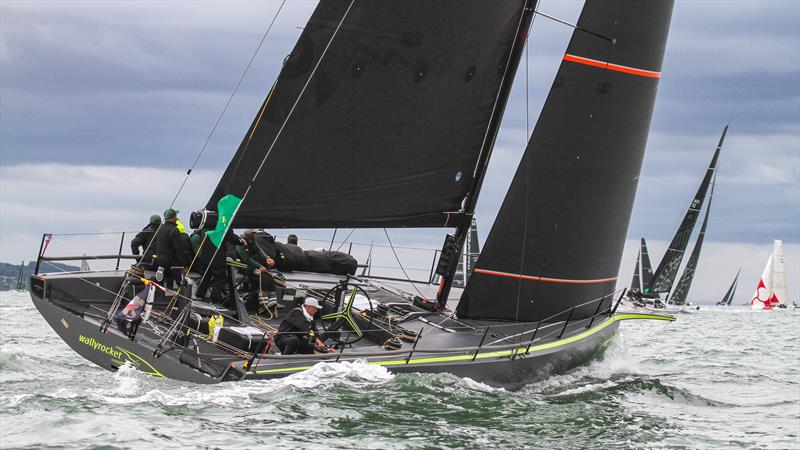
C-Tech: A quiet presence when the margins are tight in Admirals' Cup and Fastnet
by Anna Merchant|C-Tech 6 Aug 20:33 PDT

Django WR51 (WallyRocket 51) - AC1 - start Rolex Fastnet Race - July 26, 2025 - Cowes © Richard Gladwell - Sail-World.com/nz
With the return of the Admiral’s Cup and the Fastnet Race dominating headlines, performance on the water has never been more scrutinised.
But behind each result lies months of development for the C-Tech team working quietly with sailmakers and teams to get the right materials in the right place, designed precisely for the rig, the sails, and the campaign.
In recent months, C-Tech has worked closely with teams across Europe and beyond, supporting both new builds and well-established race boats preparing for major events.
One consistent theme has emerged: dialing in stiffness profiles with more precision than ever. In many cases, the process starts in the design software.
Sail designers are running detailed computer models to optimise flying shapes and load scenarios, using 5-point EI stiffness profiles as key variables. Adjusting those profiles by small margins changes how sails perform and that refinement is now core to performance gains.
These models are run in loops between teams and sailmakers, making every tweak a performance decision. C-Tech’s role is to deliver battens to exact specifications, with the lightest weight possible, while ensuring they’re robust enough to handle real-world conditions. That means understanding how each batten is treated in the rig and where strength is essential and where weight savings can be made.
We achieve this through a range of tools:
- Mandrel size: Determines the internal shape and sectional properties of each batten.
- Laminate materials: A blend of high modulus carbon (stiff but fragile), standard modulus carbon (our core material), and S-Glass (for resilience and elongation where needed).
- Laminate orientation: Fibres are layered in specific angles to optimise directional stiffness and flexibility.
- Laminate thickness and external dimensions: Carefully tuned to the application some battens transition from full carbon to full S-Glass along their length.
- Hardware integration: End fittings are designed to suit sail-specific loads and transitions, ensuring seamless load transfer and consistent sail shape.
Every batten is a custom solution. From bend profiles to weight-to-strength ratios and integration with sail hardware, these components are chosen in close collaboration with designers and sailmakers to maximise aerodynamic efficiency and durability.
Take our CT22 hollow battens, for example our most versatile and widely used range, featured extensively in this year’s Admiral’s Cup fleet. Django, a newly launched Wally Rocket, opted for a full set in soft, medium, and stiff options. This gave the team the flexibility to adjust sail shape for light inshore breezes or more demanding offshore legs, without compromising the batten’s ability to recover and return the sail to its designed shape.
Elsewhere in the fleet, Zen, an IRC52, demonstrated how updated battens can sharpen an already well-optimised setup, helping the team extract maximum performance through sail tuning.
CTP plate battens have also seen increased uptake this season, particularly in high-load headsails and areas like gaff battens in square-top mainsails for yachts under 30ft, where there’s crossover with the CT22 range.
Now stocked at our Cabanes facility in Spain, CTP battens offer excellent durability and repeatable bend characteristics. With strong inventory in Europe, teams are turning to CTP for faster turnaround, reduced shipping emissions, and reliable access especially when regatta timelines tighten.
We also saw continued adoption of CT36, our heavier-duty batten range, on large offshore multihulls and supermaxi monohulls that demand robust, high-load performance. SVR Ultim and Blackjack 100, both Fastnet line honours winners, sailed with full CT36 inventories supplied earlier this season from C-Tech Spain.
In the IMOCA class, Queguiner, skippered by Elodie Bonafous, claimed victory with new C-Tech Flexfurl systems engineered for structural furling sails in high-load environments where weight and durability are critical.
Across the board, our focus remains on building components that perform reliably not just from race to race, but year after year. That means tighter control over tolerances, integrated digital systems across our global stock network, and subtle yet significant refinements in fibre layout, resin chemistry, and custom design.
There’s no one-size-fits-all solution in high-performance sail hardware. At this level, the difference is rarely visible. It’s in how the sail loads, recovers, and responds under pressure.
That’s where we work.